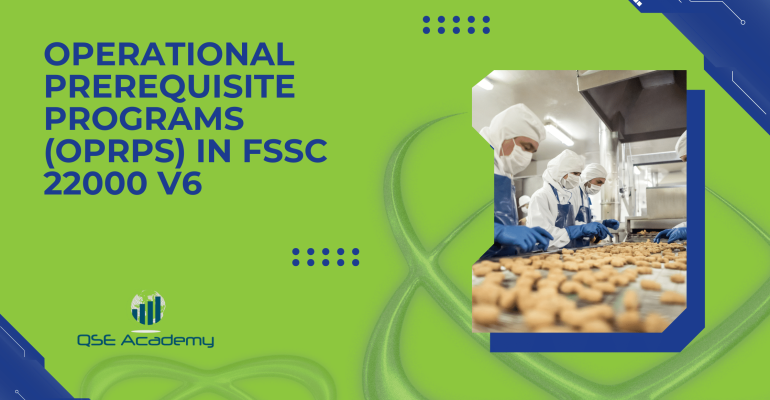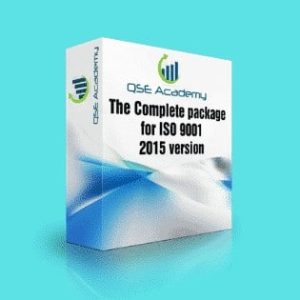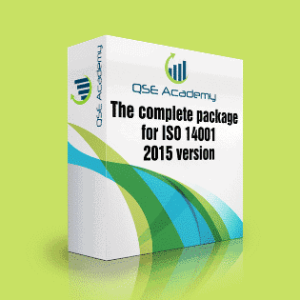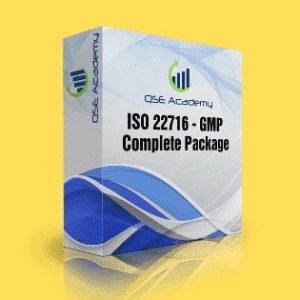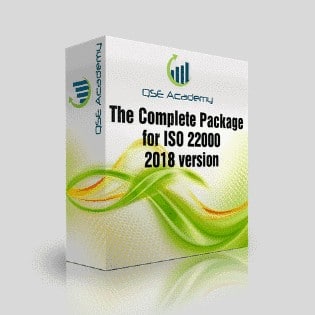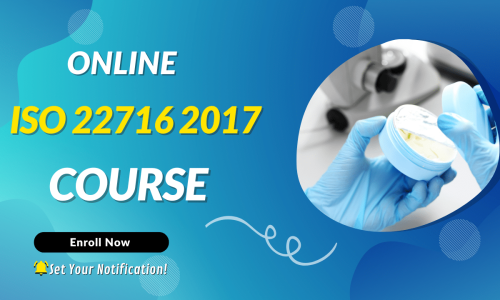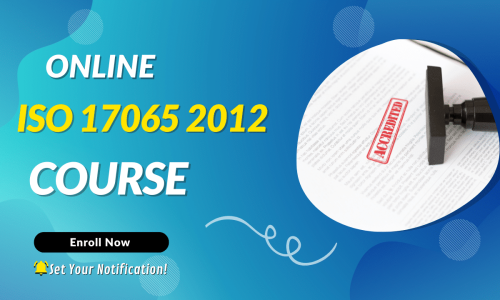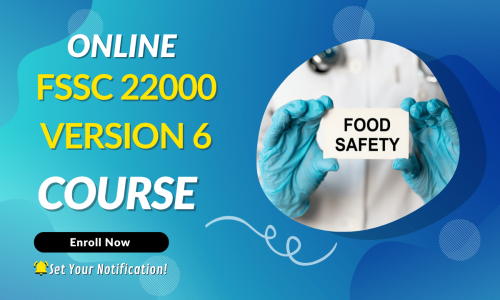Operational Prerequisite Programs (OPRPs) in FSSC 22000 V6
Last Updated on October 13, 2025 by Hafsa J.
Operational Prerequisite Programs (OPRPs) in FSSC 22000 V6
If there’s one topic that trips up even seasoned food safety professionals, it’s this: what exactly is an OPRP, and how is it different from a CCP or a PRP?
I’ve sat in more HACCP team meetings than I can count, and this question always comes up—usually followed by head tilts, a few conflicting answers, and someone eventually saying, “Let’s just call it a CCP to be safe.”
Sound familiar?
The truth is, Operational Prerequisite Programs (OPRPs) play a critical role in food safety, especially under FSSC 22000 Version 6. But if you don’t understand how to identify and manage them properly, you risk overcomplicating your system—or worse, missing key hazards that need more control.
In this guide, I’m going to break it down clearly and practically:
-
What OPRPs are (and what they’re not),
-
How to spot them in your hazard analysis,
-
How they fit into the FSSC 22000 structure, and
-
What auditors actually want to see when they review them.
If you’ve ever second-guessed whether that metal detector, sieve, or sanitation step is a CCP or an OPRP—this article is for you.
Let’s get clear on OPRPs—without the jargon, and with real-world clarity.
What Are OPRPs?
Let’s start with the basics—because if you’re not totally sure what an OPRP actually is, you’re not alone. I’ve worked with teams who’ve been running HACCP systems for years and still struggle to explain the difference between a PRP, a CCP, and this thing in the middle: the OPRP.
So, What Is an OPRP?
An Operational Prerequisite Program (OPRP) is a control measure you apply to prevent or reduce a food safety hazard to an acceptable level—but it’s not quite a CCP.
Think of it this way:
-
A PRP is a general good practice (like pest control or handwashing).
-
A CCP is a critical control point—you must control it, or people could get hurt.
-
An OPRP falls in between: it’s targeted and essential, but the risk it manages doesn’t require the same level of intensity or documentation as a CCP.
Example: A metal detector on your packaging line? That’s often an OPRP—it’s essential, measurable, and routinely monitored. But unlike a CCP like thermal processing, failure doesn’t always require a product hold or disposal. You just rerun it or check the logs.
Why OPRPs Exist in the First Place
The concept of OPRPs was introduced in ISO 22000, which forms the foundation of FSSC 22000. The idea is to make food safety systems more flexible and realistic by acknowledging that not all important controls have to meet the rigid criteria of a CCP.
This matters because calling everything a CCP leads to overloaded systems, excessive documentation, and in many cases, burned-out teams. OPRPs give you a smart middle ground.
Key Characteristics of an OPRP:
-
It specifically targets a significant hazard identified in your hazard analysis.
-
It requires measurable control criteria (like limits or targets).
-
It’s monitored, and you take action if something goes wrong—but that action isn’t always as severe as a CCP’s response.
-
It typically supports or complements your CCPs.
Common Examples of OPRPs:
-
Metal detection
-
Sifting or sieving
-
Packaging integrity checks
-
Allergen cleaning verification
-
Water treatment monitoring (if not classified as a CCP)
How OPRPs Fit into the FSSC 22000 V6 Framework
Now that we’ve nailed down what an OPRP is, let’s talk about how it actually fits into the structure of FSSC 22000 Version 6—because this isn’t just a HACCP label. OPRPs are a key part of how your food safety management system (FSMS) works as a whole.
And if you’re preparing for certification or just trying to clean up your hazard control plan, knowing where OPRPs live in the bigger picture can save you a lot of confusion.
Built on ISO 22000’s Backbone
FSSC 22000 is based on ISO 22000, which means it follows the same core structure, including:
-
Risk-based thinking
-
The PDCA (Plan-Do-Check-Act) cycle
-
A clear separation between PRPs, OPRPs, and CCPs
Your OPRPs show up in the “Operational Planning and Control” section of ISO 22000, and they’re part of what the standard calls your “hazard control plan.”
So even though you might first identify an OPRP during your hazard analysis, it becomes an operational requirement that needs to be managed, monitored, and verified—just like your CCPs.
What Makes an OPRP Different in This Framework?
Here’s the key: OPRPs are based on significant hazards, but don’t require the same level of strict control as CCPs.
That doesn’t make them less important—it just means your response to a deviation might be different.
-
Example: Let’s say you have a sifter to catch foreign material. It’s effective, measurable, and monitored. That’s likely an OPRP. But if you miss a screen check, you might clean and re-screen product—not destroy it, like you would if a CCP failed.
That’s the flexibility ISO 22000 and FSSC 22000 bring: recognizing control without overreacting.
OPRPs in the PDCA Cycle
-
Plan: Identify the hazard and the OPRP needed.
-
Do: Put it in place with proper procedures and training.
-
Check: Monitor its effectiveness and record the results.
-
Act: Respond to deviations, and continuously improve.
That’s why OPRPs aren’t just a box on a flowchart—they’re active elements in your FSMS.
Identifying OPRPs in the Hazard Analysis
Here’s where most teams start to second-guess themselves. You’ve completed your hazard analysis, but now you’re staring at a list of control measures thinking, “Is this a CCP? A PRP? Or maybe… an OPRP?”
This is the part where clarity matters most—because misclassifying controls can lead to overcomplicated systems, missed risks, or audit findings.
How Do You Know It’s an OPRP?
In a nutshell:
An OPRP is a control that reduces or prevents a significant hazard, but it doesn’t require the tight, fail-safe level of control that a CCP demands.
Here’s how I typically guide teams through the process:
Use a Logical Decision Tree
Most companies use a decision tree or logic diagram during hazard analysis. Whether it’s Codex-based or adapted from ISO 22000, it helps you walk through:
-
Is the hazard significant?
-
Is there a specific control measure to address it?
-
Does failure of this control lead to unacceptable food safety risk?
-
Can the control be monitored and action taken if it fails?
If the answer to all of those is yes, but the risk isn’t quite critical enough to justify CCP-level rigor—that’s usually your OPRP.
Real-World Examples
Let’s break it down with a few examples:
-
Metal detection after packaging
Likely an OPRP. It’s measurable and controls a physical hazard, but failure may allow re-inspection or rework—not full product destruction. -
Allergen changeover cleaning verification
Often an OPRP. Allergen cross-contact is a serious hazard, but it’s typically controlled through cleaning and validation rather than CCP-style monitoring. -
Sieve inspection on dry goods
Could be an OPRP if you routinely find foreign matter risk that doesn’t justify a CCP but still needs focused control.
Common Missteps
-
Calling everything a CCP just to be safe—this overloads your system with unnecessary documentation.
-
Treating important controls as just PRPs when they really carry more risk.
-
Failing to justify your classifications—this is one of the most frequent audit findings.
I’ve seen teams mark a control as a PRP because “that’s how we’ve always done it,” only to have auditors come in and ask: “Where’s your risk assessment that supports that?”
You need to be able to explain why something is (or isn’t) an OPRP.
Implementing and Managing OPRPs
So, you’ve identified your OPRPs. Great—now what?
This is where many food businesses start to stumble. I’ve seen solid hazard analyses fall apart in execution simply because the OPRPs weren’t implemented in a way that was practical, trackable, or well-understood by the people responsible for them.
Here’s how to put those controls into action—and keep them working.
Start with Clear, Documented Procedures
Every OPRP needs its own procedure that includes:
-
What the control is
-
Why it exists (link it back to the hazard)
-
Who is responsible for it
-
How it’s monitored
-
What the limits or targets are
-
What to do if something goes wrong
Keep it simple, but specific. If the control is a metal detector, include the sensitivity limits, test frequency, corrective action steps, and who signs off on daily checks.
Assign Responsibility—And Train for It
Too often, OPRPs are assigned to someone who never got the full picture. Don’t assume operators know why they’re doing a check just because it’s in the SOP. Explain:
-
Why it matters
-
What can go wrong
-
What action they’re empowered to take
At one site I visited, a line operator was dutifully checking a sieve every two hours—but had no idea that it was an OPRP linked to controlling a specific physical hazard. Once he understood the why, he started noticing things no one else caught—and helped prevent a near miss.
Monitoring and Control Tools
Depending on the OPRP, your monitoring could include:
-
Visual inspections
-
Digital logs
-
Physical tests (e.g., metal detection challenge tests)
-
Sensor alerts or automated controls
-
Manual sign-offs
What matters is that it’s reliable, consistent, and recorded.
Responding to Deviations
Unlike PRPs, where corrective action may not be urgent, OPRPs require a documented, timely response. But unlike CCPs, this response might allow for rework, investigation, or additional inspection rather than automatic rejection.
Example: If your allergen cleaning verification fails, you might re-clean and retest rather than scrapping product—but you need to show that this decision was based on a defined process, not a last-minute guess.
Don’t Forget Daily Review and Trend Monitoring
OPRPs often reveal patterns. Is the same deviation happening repeatedly? Is there a gap in training or maintenance? Reviewing your OPRP records regularly helps catch issues early—and shows auditors you’re staying proactive.
Verification and Validation of OPRPs
Identifying and implementing OPRPs is one thing—but if you can’t prove they’re working, you’ll have trouble during audits and even more trouble if something actually goes wrong.
This is where verification and validation come into play—and yes, they’re two very different things. A lot of people use the terms interchangeably, but under FSSC 22000 V6, you’re expected to understand and apply both clearly.
First, Let’s Define the Two
-
Validation is about making sure the control can work. It happens before or during initial implementation.
-
Verification is about confirming that the control is working—on an ongoing basis.
Think of validation as asking, “Is this control appropriate for the hazard?”
And verification as asking, “Is it consistently being followed and effective?”
Validating an OPRP
Validation might include:
-
Reviewing scientific or technical data
-
Running trials or challenge tests
-
Consulting regulatory or industry guidance
-
Reviewing historical data on hazards and control effectiveness
Example: Before implementing a new allergen cleaning process, you might run swab tests to prove that the procedure removes all protein residues to an acceptable level.
Once validated, you can document that this specific procedure is capable of controlling the identified hazard.
Verifying an OPRP
Verification activities could include:
-
Reviewing monitoring records
-
Observing operators performing checks
-
Testing equipment function (e.g., test wands for metal detectors)
-
Conducting internal audits focused on OPRPs
-
Trending data for consistency and repeat issues
This is where many companies fall short. They assume that if there’s a checklist being filled out, the OPRP is working. But without regular review and follow-up, things can drift—and auditors will notice.
How Auditors View It
Auditors will want to see:
-
How you validated each OPRP
-
How often you verify it
-
What happens when you find a problem
-
Evidence that you’ve taken action based on what you’ve found
One facility I worked with had spotless metal detection logs—but the equipment hadn’t been calibrated in six months. The records looked fine on paper, but they hadn’t verified the equipment’s actual performance. That resulted in a major nonconformity.
Keep It Clear and Proportional
Your verification activities should match the risk level of the hazard being controlled. Don’t bury yourself in testing and documentation—but don’t cut corners, either.
Pro Tips and Insider Insights for Managing OPRPs Effectively
After years of helping food businesses prepare for audits and build stronger hazard control plans, I’ve seen exactly where teams get stuck—and what separates a reactive system from a proactive one. These tips are pulled straight from real-world experience and can make a huge difference in how you manage your OPRPs.
Pro Tip #1: Not Every Process-Level Control Needs to Be a CCP
If you’re calling every control a CCP “just to be safe,” you’re overcomplicating your system—and probably overwhelming your team.
A well-managed OPRP can be just as effective, with less administrative burden.
One bakery I worked with reduced their CCPs from eight to three after reassessing their hazard analysis—and their audit score improved.
Pro Tip #2: Trend Your OPRP Data Like You Would for CCPs
Don’t just collect checklists—analyze the patterns.
Recurring deviations might point to equipment wear, training gaps, or even supplier issues. Auditors love seeing proactive reviews of control data.
Pro Tip #3: Use Color-Coded Risk Matrices During Hazard Analysis
When trying to decide if a control should be an OPRP or CCP, a visual risk matrix can help teams align quickly and support decisions with logic—not guesswork.
Pro Tip #4: Practice “What If” Scenarios with Operators
Ask your team: “What would you do if this control failed?”
You’ll quickly find out who understands the control—and who just checks boxes. Use this to fine-tune your training and documentation.
Pro Tip #5: Keep Your Justification Notes Audit-Ready
Don’t just classify controls—explain why.
Maintain a quick-reference sheet showing your logic for PRP, OPRP, or CCP classification. It shows auditors that your system isn’t just compliant—it’s thoughtful and risk-based.
Common Mistakes to Avoid and FAQs About OPRPs
When it comes to Operational Prerequisite Programs, even experienced teams can get tangled up. These are the mistakes I see most often during site assessments and audits—and the questions that come up again and again.
Common Mistakes
Mistake 1: Confusing PRPs with OPRPs
One of the most common issues. Just because a procedure is preventive doesn’t mean it’s an OPRP.
If it doesn’t control a significant hazard that’s measurable and monitored, it’s probably just a PRP.
Mistake 2: Promoting Controls to CCPs Without Cause
Out of fear, some teams classify everything as a CCP. But too many CCPs can lead to “checklist fatigue” and gaps in actual risk management.
OPRPs exist for a reason—use them.
Mistake 3: Poorly Documented Justifications
Auditors don’t just look at your control plan—they want to know why you classified a control the way you did. If you can’t explain the logic, it’s a red flag.
Mistake 4: No Follow-Up on Deviations
Treating an OPRP deviation like it’s “not that serious” is a fast track to audit trouble.
You need a clear corrective action process—even if it’s less severe than for a CCP.
Mistake 5: One-and-Done Validation
Some teams validate OPRPs during implementation and never revisit them.
If your process, equipment, or ingredients change, your validation may no longer hold.
Frequently Asked Questions (FAQs)
Q1: Can an OPRP become a CCP later?
A: Yes. If the risk profile changes—like new customer requirements, higher hazard levels, or new legal thresholds—you may need to reclassify. Regular FSMS reviews should catch this.
Q2: Is there a limit to how many OPRPs a facility should have?
A: No hard limit. It depends entirely on your hazard analysis. Some operations may only need one or two; others might have several. The key is to justify each one clearly.
Q3: Are OPRPs audited the same way as CCPs?
A: Not exactly, but they’re still audited seriously.
Auditors will expect to see procedures, monitoring records, staff training, and evidence of verification and corrective action—just like with CCPs, but with slightly more flexibility.
Q4: Can a PRP evolve into an OPRP?
A: Absolutely. If a general procedure starts being used to control a significant hazard with measurable outcomes, it may need to be reclassified and strengthened accordingly.
Making OPRPs Work for You
Let’s recap: OPRPs aren’t just a regulatory term—they’re a smart, flexible way to manage real food safety risks without overwhelming your team or turning every control into a high-stakes CCP.
When you understand how to identify, implement, verify, and explain your OPRPs, you build a system that’s not only compliant—it’s efficient, audit-ready, and grounded in logic.
FSSC 22000 Version 6 gives you the structure. But how you apply it? That’s where leadership, training, and strategy come into play.
I’ve worked with manufacturers, processors, and suppliers across every sector—and I can tell you with confidence: the teams that get OPRPs right are the ones that stay confident under pressure, pass audits with ease, and build systems that actually work on the production floor.
Your Next Step
If you’re reviewing your hazard control plan, prepping for certification, or just second-guessing your classifications, here’s how to move forward:
-
Need a clearer way to decide between PRPs, OPRPs, and CCPs?
Download our free OPRP Decision Tree Template—built from the same logic we use in real-world implementations. -
Want someone to walk through your current hazard analysis with you?
Book a quick FSMS review session. We’ll help you sort through the gray areas and clean up your control plan—fast. -
Building a team that actually understands this stuff?
Ask about our training workshops for food safety teams. We cover exactly what OPRPs are, how they work, and how to manage them in the real world—not just on paper.
A strong FSMS isn’t just about passing audits—it’s about knowing your system can handle what happens when things don’t go as planned.
OPRPs help you get there. And we’re here to help you get them right.
Whether it’s ISO 9001, ISO 22000, or the cosmetics-focused ISO 22716, I’ve spent my career I’m not here to call myself an expert—I prefer “enthusiast” because I truly love what I do. When I’m not writing about standards, you’ll probably find me playing Piano 🎹, connecting with people, or diving into my next big project💫. I’m an engineer specialized in the food and agricultural industry
make ISO standards less intimidating and more approachable for everyone.
turning complex jargon into clear, actionable steps that businesses can actually use.
There’s something incredibly rewarding about helping people navigate food safety and quality management systems
in a way that feels simple, practical, and even enjoyable.
I have a Master’s in QHSE management and over 12 years of experience as a Quality Manager
I’ve helped more than 15 companies implement ISO 9001, ISO 22000, ISO 22716, GMP, and other standards
My clients include food producers, cosmetics manufacturers, laboratories, and service companies
I believe quality systems should be simple, useful, and efficient.

